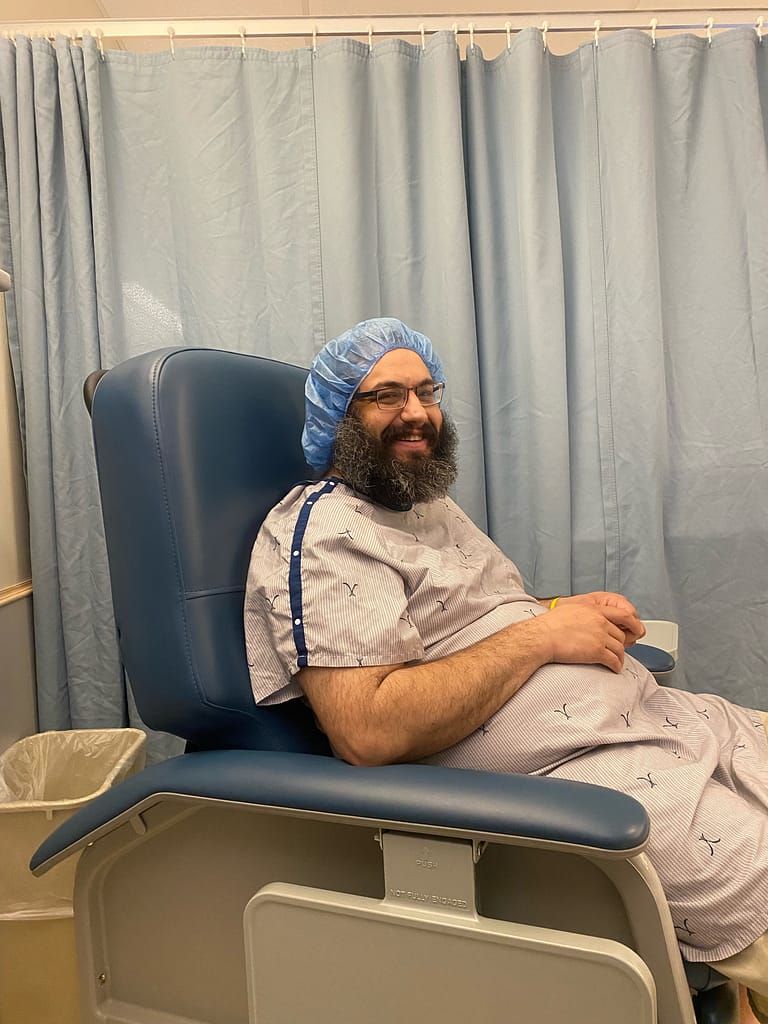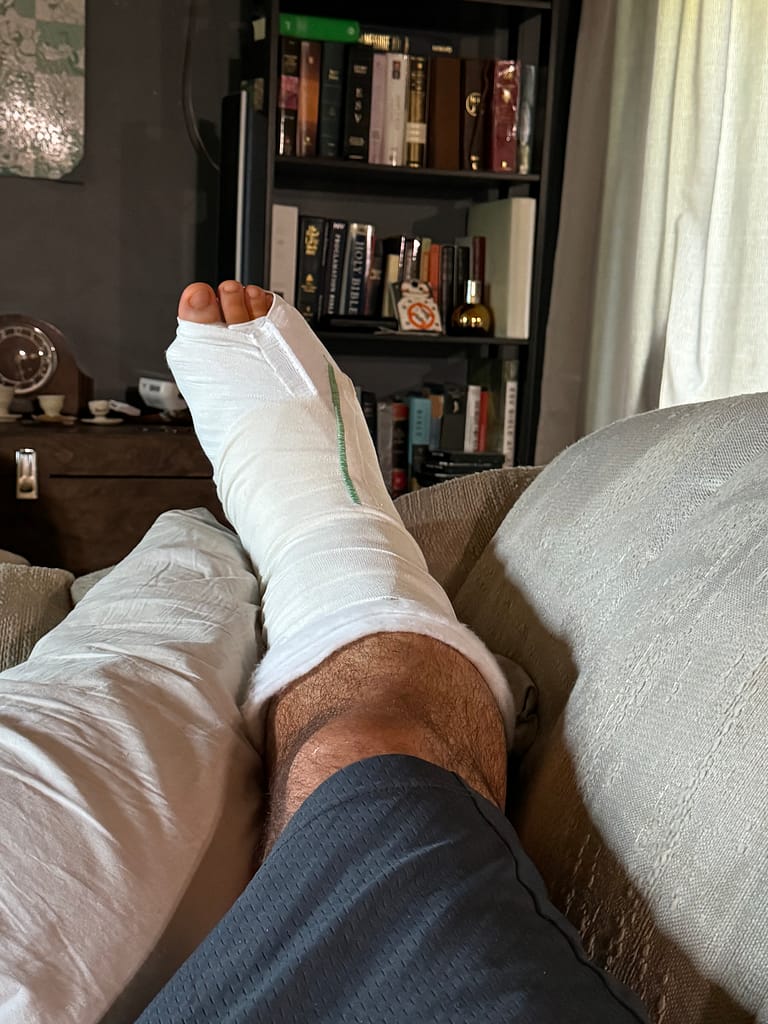On June 4th, I got a call from the Hospital in Prince George. The orthopaedic surgeon had reviewed my case, and given the nature of my injury, the surgeon really wanted to get me into surgery as soon as possible, and was hoping to do so as soon as a slot opened up.
We travelled down to Prince George on the 5th, staying overnight with some friends-of-friends and were scheduled in for surgery first thing on the 6th.

After going through the intake procedure, and getting myself prepared, we met with the nurses, anesthesiologist, and, eventually the surgeon, going over various aspects of the plan.
On the surgery timetable, I was booked in for an Open Reduction internal fixation (ORIF), a surgery that was scheduled to take around 45 minutes. ORIF is a surgery where the goal is to realign the joints, and repair the ligaments holding them together, using hardware to stabilize the joints until things heal fully. As it is quicker, cheaper, and has relatively low rates of complications, it has often been the preferred initial surgical method for these types of injuries. While not the only surgical solution, it has generally been considered the more “conservative” of the surgical approaches.
However, when I met with the orthopaedic surgeon, he was pretty candid about the options.
While ORIF can be an effective method of treatment, and has some benefits in that it keeps the joint as a joint, many people require follow up surgery to remove the hardware at a later date, and, when there has been a more serious injury, some people develop early onset osteoarthritis, or issues with their arch, and will therefore also require a subsequent fusion surgery to to resolve this issue as well.
In more severe injuries, therefore, recently, there was some discussion and debate about whether or not it was best to fuse the bones initially, and reduce the likelihood of subsequent surgeries if necessary. He noted that there were signs of multiple fractures on the X-rays and CT Scans, in addition to the dislocation and torn ligaments, and that, depending on the severity of the injury, fusion may be the better option.
The doctor admitted, it was hard to know for sure until he began surgery, but if it looked bad, he would probably switch up his plans and perform a fusion (primary arthrodesis) initially, rather than the scheduled ORIF. It would be a longer, more complicated surgery initially, and does result I a little loss of flexibility and movement but, if the injury was sufficiently severe, it would likely be a worthwhile trade off.
As we made our way to the operating theatre and prepared to go under, the surgeon went over the plans one last time, the anesthetist advised me to think of some happy thoughts, and before I knew it, I was out.
All told, the surgery took a bit over 2 hours, though to me, it could have just as easily been a minute.
The fact that the surgery had taken that long meant only one thing — the injury had been severe enough to warrant a primary fusion surgery.
Primary Arthrodesis (fusion) involves removing the cartilage between the affected joints, and securing them with screws, pins or plates to allow the joints to eventually heal together as a single bone. While the loss of movement between the joints is certainly a trade off, fortunately, the joints in the lisfranc complex don’t actually move that much anyway, and most people who are not elite, high level athletes, don’t really tend to have too many struggles as a result.
As I began to come around in recovery I was groggy and a little disoriented, but I already know things were improved. Following the injury, I’d been having a lot of pain in and around my big toe, and the joint where it connected to the sole of my foot. There was a pretty noticeable gap between my big toe and my first toe, and I couldn’t move them together at all.
As I came round, although there was a lot of pain from the surgery itself, my toes no longer hurt. Likewise, I’d been experiencing a lot of pain along the outside of my foot, and into my ankle, which was at times even more severe than the pain in the lisfranc joint itself, and again, this pain had completely gone.
I looked down and noticed that my was in a soft cast, and though it was tight, heavy, and uncomfortable, I was aware that everything suddenly felt much more manageable — far moreso than prior to surgery, where even the slightest movement in my unsupported foot and ankle would leave me with unimaginable shooting pains.
Maybe it was just the medication talking, but I’d really prepared myself for the pain to get worse, before it got better, and had definitely read plenty of horror stories about just how unimaginably painful the post-operative period could be, but as I continued to come round in recovery, the improvement as incredible.
I’d assumed we’d probably remain in Prince George overnight before being discharged, but after getting some properly fitted crutches, and a prescription for pain medication, we were able to leave the hospital, by early afternoon.
Our hosts in Prince George were more than happy to put us up for a few more days. But knowing that I’d be much more comfortable and confident navigating our own home while on crutches, and pretty strong medication, and given that we still had the ability to make it home before bed time, we decided to make our way back to Hudson’s Hope the same day.
The journey home was a bit of a blur, but before I knew it, we were back, and I made myself comfortable for what was sure to be a long recovery.

I’d been warned that the first few days after surgery were the worst. I was advised to keep my foot elevated to keep the swelling down to avoid putting any weight on it at all. While I certainly can’t say it was particularly pleasant, and I definitely felt the pain, it was certainly nowhere near as severe as I had prepared myself for. Between pain medication and sleep, I managed to make it through the first few days without too much pain.
Moving around on crutches proved to be the biggest frustration, as I struggled to do even the simplest of tasks for myself, but family and friends really stepped up to help me out, and before I knew it, we were preparing for our first Sunday service.
I’d been warned that I shouldn’t push myself too much, too fast, and that I shouldn’t count on being able to lead our service this quickly after surgery. While we were certainly prepared to cancel the service if need be, I really felt God’s grace to proceed as planned.
I spent Saturday preparing, and while the meds certainly meant I was a little foggier than I’d like by the time I went to bed, I felt I had the structure of the sermon God had asked me to preach. Sunday came, and went, and while I can’t say it was the best sermon I’ve ever preached, being together with friends, and worshipping with our church family was exactly what the doctor ordered — perhaps not my orthopaedic surgeon, but certainly the Great Physician.
The next few week fell into a familiar pattern. Rest and elevation as much as I could, work I could complete online, by phone, or in the thrift store where appropriate, some visits and connecting with people, and worship together on Sunday.
The pain continued to reduce, and soon, the uncomfortable cast became a bigger frustration than the pain itself. Time moved more slowly than I’d have liked, but progress — even slow progress — made a difference in my mood.
We purchased a knee scooter, which made a huge difference to my mobility and independence, and though I knew it would still be a long time before I would be able to put weight on it, it made life much easier. Positive news came regarding my MSP coverage, with my ER visits, and surgery being covered in full. Each week, I was able to do a little more, and before too long, I had my follow up appointment booked for cast removal, and follow up x-rays — June 26th — which gave me something tangible to work towards.
The final week before our return visit to Prince George really dragged a lot, Typically, this appointment would come at around the 2 week mark, but we had delayed until nearly 3 weeks, so our daughter could finish school, and we would not have to worry about either leaving her behind, or pulling her out of school. Still, knowing that the cast could probably have come off, and the stitches could have been removed a week earlier, certainly made those last few days really feel like unending.
However soon, the time came for us to travel back to Prince George for the follow up appointment, when we would really know for sure how things were progressing.
We travelled down to Prince George on the 25th, making the most of our journey, and the time we had in the city, not knowing what the results of the following day’s appointment would be.
I’ll share more in the next update, but suffice it to say, the results, they were as good as we could have hoped.
There’s still a lot of recovery to go. Please continue to pray for quick, total, and complete healing, and a quick return to full function with no long-term challenges.
I’m still in a boot, and will be non-weight bearing for at least another month, so your thoughts, prayers, and support continue to be appreciated more than we can say. We’ll be travelling back to PG at least once more — and probably more than that — for further follow up, and I will likely also require physiotherapy once discharged by my orthopaedic surgeon — an out-of-pocket expense I’m still not completely sure how we will be able to find.
Still, God is good, and we continue to move forward in his strength and by his grace,

0 Comments